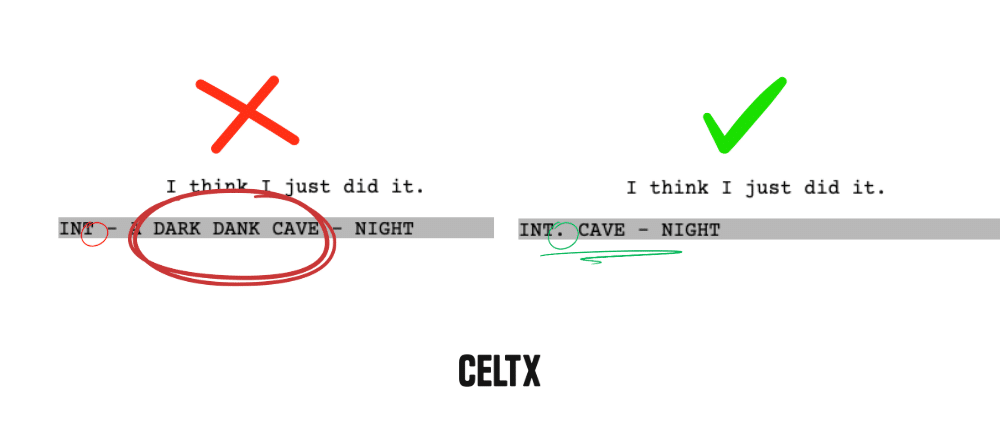
So, you’ve just sat down to write your script. You have a solid outline for your plot and a cast of killer characters ready to come to life on the page. Now for the first, crucial piece of the puzzle: formatting.
Before your characters can speak a word of dialogue or perform a single action, you need to tell the reader where they are and when. This is where scene headings — also known as “sluglines” — come in. A scene heading is a simple, single line that acts as a signpost, setting the stage for every new scene. It’s the very first piece of screenwriting grammar you need to master.

And the most fundamental part of a scene heading is understanding whether your scene takes place inside, which brings us to the crux of the matter: what does INT. mean in a script?
Let’s find out!
Table of Contents
- The Anatomy of a Scene Heading (The Slugline)
- What Does ‘INT.’ Stand For? A Simple Answer
- How to Use ‘INT.’ Correctly: Rules, Examples, and Best Practices
- What About ‘EXT.’?
- Navigating Between Worlds: The ‘INT./EXT.’ Hybrid
- Why Scene Headings Are So Strict (And How They Help You)
- Advanced Applications: Continuous Action & More
- Common Mistakes to Avoid
- FAQs
- Conclusion
The Anatomy of a Scene Heading (The Slugline)
Think of a scene heading as a simple formula. It’s designed to be instantly readable by anyone involved in a film production, from the director to the location scout. A standard scene heading has three key components:
- The Location Descriptor: This tells you whether you’re inside or outside. It will almost always be either
INT.orEXT.. - The Specific Location: This tells you precisely where the scene is happening (e.g., COFFEE SHOP, HOSPITAL, MOUNTAIN PASS).
- The Time of Day: This tells you when the scene takes place. For most cases, this will be
DAYorNIGHT.
Combined, these three elements form a single, powerful line of information that sets the stage for the rest of your scene.

What Does ‘INT.’ Stand For? A Simple Answer
Simply put, INT. is the industry-standard abbreviation for “INTERIOR.”
This two-letter-plus-period signifier is used to tell your reader—whether that’s a producer, director, actor, or studio executive—that the scene about to unfold takes place inside an enclosed environment. This could be anything from a bustling restaurant to a quiet bedroom to the inside of a car.
Why not just write out “INTERIOR” in full? Because in screenwriting, every inch of page space matters. The goal is to be as concise and clear as possible, and the strict adherence to formatting helps create a consistent visual flow that’s easier to read and, ultimately, easier to produce.
How to Use ‘INT.’ Correctly: Rules, Examples, and Best Practices
Using INT. is straightforward, but there are a few golden rules you must always follow. Believe it or not, getting these basics wrong can be a red flag to a busy script reader.
- Rule 1: Always start with
INT.The location descriptor is the very first thing that should appear in your scene heading. There are no exceptions to this rule. - Rule 2: Capitalize Everything. Scene headings are always written in all caps, and
INT.is no different. - Rule 3: Don’t Forget the Period.
INTis an abbreviation, and the industry standard requires a period at the end. It’s a small detail, but it’s a non-negotiable one.
Let’s look at a few examples of how to put this into practice:
Basic Example:
INT. LIVING ROOM - DAY
This tells us the scene takes place inside a living room during the daytime. Simple, right?

More Specific Location:
INT. ST. JUDE’S HOSPITAL, WAITING ROOM - NIGHT
Here, we’ve added a more specific sub-location. This level of detail can be very helpful to a production designer or location scout.

Inside a Vehicle:
INT. JOSH'S CAR - DAY
Even though a car is on the move and technically exists outside, the scene is taking place inside the enclosed vehicle, so it requires an INT. heading.
PRO TIP: Remember, a new scene heading is needed every time you change location, even if you’re just moving from one room to another in the same building.
For example: INT. JOHN'S APARTMENT, KITCHEN - DAY followed by INT. JOHN'S APARTMENT, LIVING ROOM - DAY.
What About ‘EXT.’?
Of course, not every scene in your script will be inside. For action happening under the sun, moon, and stars, you would use EXT., the abbreviation for “EXTERIOR.”
Like INT., EXT. is placed at the very beginning of a scene heading to indicate that the scene takes place outside.
Example:
EXT. MOUNTAIN PASS - DAY
Note: While EXT. is an essential part of the screenwriting lexicon, we’ll dive into the specifics of using it in a future, dedicated article to be published soon. Stay tuned!
Navigating Between Worlds: The ‘INT./EXT.’ Hybrid
What if you’re writing a chase scene where characters are jumping in and out of a car? Or a conversation that starts on a porch and moves inside without a pause? This is where the INT./EXT. hybrid heading comes in handy.
Example:
INT./EXT. CAR - DAY
Using this heading allows you to write action and dialogue that seamlessly shifts between the inside of the car and the outside without having to create a new scene heading every few seconds. This helps your script flow more smoothly and prevents it from becoming clunky and hard to read.
Why Scene Headings Are So Strict (And How They Help You)
This might all feel like a lot of rigid rules for something so simple, but there’s a very good reason for it. Film and television are collaborative industries. A single script can be read by dozens, if not hundreds, of different people, all with different roles: directors, cinematographers, production designers, location scouts, and actors.
The script is the detailed creative blueprint of the project. If every writer used their own unique formatting, it would create chaos. Industry-standard formatting ensures clarity and consistency, no matter who you are or what part of the production you’re working on.

For you as the writer, these rules aren’t meant to curb your creativity—they’re meant to empower it. By giving you a solid, reliable framework, you can pour all your energy into your story, confident that your blueprint is sound.
Ready to put this knowledge to the test without worrying about the technicalities? Celtx automates professional script formatting so you can focus on the story. Our intuitive platform ensures every slugline, character name, and action line is formatted to industry standards, so you never have to think about margins, caps, or periods again.
Click here to get started – it’s free!
Advanced Applications: Continuous Action & More
As you get more comfortable with the basics, you’ll encounter more advanced uses for scene headings.
Continuous Action: When a character moves from one location to another without a break in the action, you can use CONTINUOUS.
Example:
INT. KITCHEN - DAY CHLOE enters the kitchen, grabs the keys from the counter. INT. HALLWAY - CONTINUOUS She rushes out the front door.
This tells the reader that the action is uninterrupted, even though the location has changed.
Time of Day Nuances: While DAY and NIGHT are the most common, you can use other time notations for specific effect, as long as they are clear.
Examples:
INT. BAR - DUSK INT. OFFICE - MOMENTS LATER
Common Mistakes to Avoid
- Forgetting to Capitalize: All scene headings, including the location, must be in all caps.
Int. coffee shopis incorrect;INT. COFFEE SHOPis correct. - Skipping the Period:
INTis not the same asINT.. Always include that final period! - Using Descriptions in the Heading: Don’t try to add descriptions or camera directions to your slugline. Keep it simple.
INT. A DARK, DANK CAVE - NIGHTis incorrect;INT. CAVE - NIGHTis correct.

Remember, every creative professional reading your script will thank you for adhering to these standards.
FAQs
In most cases, yes. DAY and NIGHT are the universal standard for indicating the lighting of a scene, which is crucial for production. However, for a specific effect or to signify a passage of time, you can use terms like DAWN, DUSK, LATER, or SAME.
You can specify a sub-location by separating it with a comma. For example: INT. JOHN'S APARTMENT, KITCHEN - DAY. This provides more clarity for production teams.
You must start a new scene heading every time you change the location or the time of day. Moving from a bedroom to a hallway requires a new scene heading, as does moving from a day scene to a night scene in the same location.
A scene heading (slugline) is the single line that defines the location and time of the scene. An action line (or description) is the prose that follows, describing what is happening visually in the scene. INT. LIVING ROOM - DAY is a scene heading. A cold wind rattles the window. CHLOE pulls a sweater on. is an action line.
Conclusion
Congratulations, you’ve just mastered the first, most critical piece of screenwriting formatting. While it might seem like a small detail, the correct use of a scene heading starting with INT. is the difference between a professional script and an amateur one.
By embracing these rules, you’re not just creating a story—you’re building a clear, actionable blueprint for a film. And that blueprint is the nucleus of your entire project.
The possibilities are truly endless for your scripts, but it all starts with your first scene heading. Where you go from there is up to you, but know that Celtx is here to help you every step of the way, from script to screen.
Start writing your next big idea with Celtx and explore our full suite of professional tools for every stage of your creative process.
Sign up today!
Up Next:

Action Lines: The Do’s and Don’ts to Make Your Script Move
Now that you’ve mastered the ins and outs of INT., it’s time to build out your scene. Scene headings are just the beginning; the action that follows is what brings your story to life
